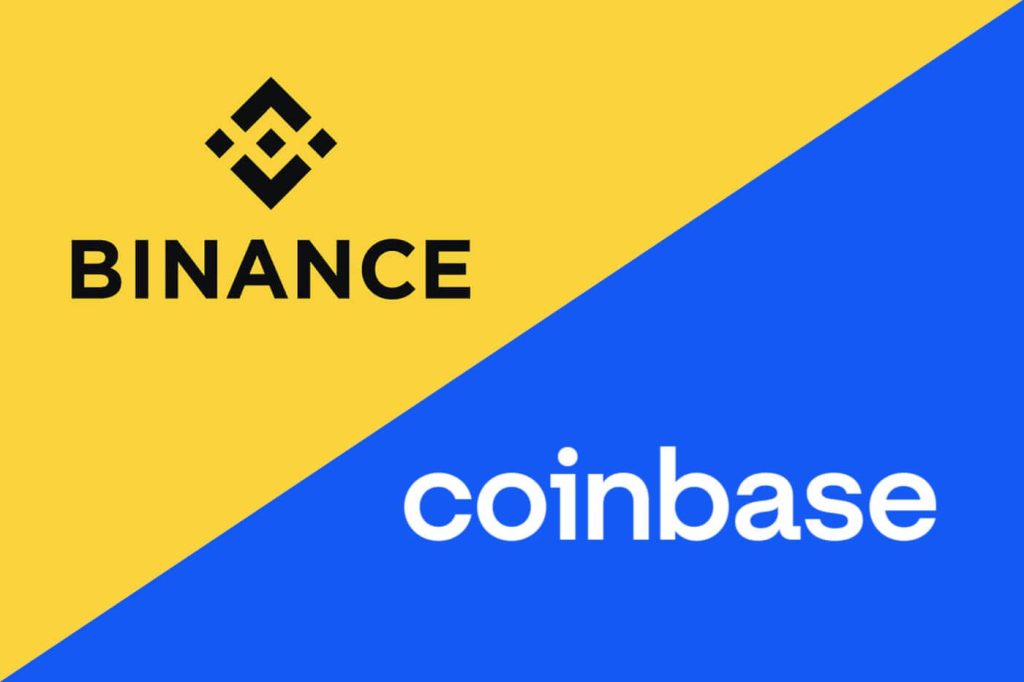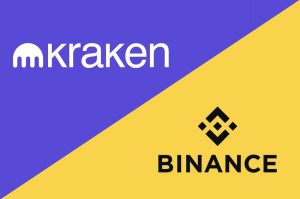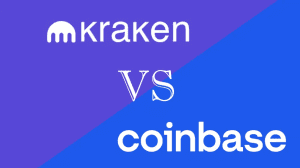Binance vs. Coinbase – 2023 Comparison

In the dynamic world of cryptocurrencies, selecting the right exchange is pivotal. Binance and Coinbase have emerged as key players, each offering distinctive features and services. But when it comes to Binance vs. Coinbase, which should you choose?
This comprehensive comparison provides an in-depth analysis of both platforms, aiding users in making informed decisions about their crypto investments.
Kraken vs. Coinbase Head-to-Head Comparison
Take a quick look at Kraken vs. Coinbase.
Binance
- Trading options: Margin, futures, staking, and more.
- Additional services: Trust Wallet, 7 order types, diverse altcoins.
- Crypto support: 600+ outside US, 100+ inside US.
- Global availability: 180+ countries.
- App availability: Unavailable in Hawaii, Texas, Vermont, and New York.
- Security: Cold storage, FDIC-insured USD balances for Binance.US, address whitelisting, 2FA.
- Fees: Tiered structure with reduced fees for high volume.
Pros
- Low fees
- 600+ cryptos
- Global Availability
- 7 order types on Binance
Cons
- limited Binance.US
- Complexity for beginners
- Regulatory trouble
Coinbase
- Trading options: Spot, limited margin (up to 3x, now disabled).
- Additional services: Hot wallet for easy transfers, user-friendly interface.
- Crypto support: 250+ cryptocurrencies.
- Global availability: 100+ countries.
- App availability: Fully accessible in most regions, except Hawaii.
- Security: 98% of assets in cold storage, PGP encryption, security keys, 2FA.
- Fees: Varying fees based on transaction size and payment method.
Pros
- User friendly
- Secure storage
- High crypto support
- Easy funding options
Cons
- Higher transaction fees
- Unavailable in all countries
Our Binance vs. Coinbase Methodology
Our approach involves a detailed evaluation of essential factors, including features, security protocols, available cryptocurrencies, transaction fees, and user experience. By scrutinizing these elements comprehensively, this guide will present a holistic view of Binance vs. Coinbase. Therefore, readers can assess which platform aligns best with their trading goals and preferences.
Binance vs. Coinbase – Features
Binance and Coinbase cater to distinct user bases, resulting in substantial differences in their feature sets. Both crypto exchanges offer mobile applications with watch lists and live price tracking, thus ensuring users stay up-to-date on market movements. However, the similarities end there.
Binance
Binance stands out with its advanced charting capabilities, offering users many options for adding indicators and overlays. This feature-rich charting interface empowers traders with in-depth market analysis tools. Hence, it aids in strategic decision-making.
Additionally, Binance provides users with public application programming interface (API) keys, enabling seamless integration with various software tools for customized trading experiences.
Furthermore, Binance offers a diverse array of 7 order types, which allows users to execute trades precisely according to their strategies. Another notable feature is the option to use Trust Wallet, a third-party digital wallet integrated into the Binance platform. This integration enhances user flexibility and enables secure storage and management of various cryptocurrencies.
One of Binance’s most significant advantages is its global accessibility, allowing users from over 180 countries to trade on the platform. However, it’s important to note that the US platform is available in only 46 states, excluding Hawaii, New York, Texas, and Vermont. Despite these limitations, Binance’s wide reach accommodates traders from diverse corners of the world.
Note:
On June 5, 2023, the US Securities and Exchange Commission (SEC) took legal action against Binance Holdings Ltd., BAM Trading Services Inc., and founder Changpeng Zhao, alleging violations of US securities laws. In response, Binance issued a statement reaffirming the safety and security of all user assets on Binance and its affiliated platforms, including Binance.US. The company asserted its commitment to vigorously defend against the SEC’s allegations.
Coinbase
On the other hand, Coinbase particularly focuses on US residents and offers a distinct set of features catering to the American market. One prominent feature is its secure standalone digital hot wallet, where users get a seamless experience across Coinbase and other exchanges. This integrated wallet simplifies fund management and enhances user convenience.
Additionally, Coinbase allows users to withdraw funds directly to their PayPal accounts, streamlining the withdrawal process. Therefore, it especially benefits users seeking swift and convenient access to their funds.
While Binance primarily targets international traders, Coinbase extends its services to users in over 100 countries and 49 US states, with Hawaii being the exception. The exchange further enhances user engagement through its newsletter, delivering the latest cryptocurrency news directly to users’ inboxes. As a result, users stay up-to-date about market trends to make the right trading calls.
Coinbase also offers the optional Coinbase Pro platform for users seeking advanced charting features. It allows traders to track exponential moving averages (EMAs) and provides detailed technical analysis tools for precise decision-making. Additionally, customers can earn cryptocurrency by watching short videos, providing an innovative way to accumulate digital assets.
Security
Security is paramount in crypto trading, and both Binance and Coinbase implement robust measures to safeguard user assets. While both platforms are considered secure, Coinbase holds a stronger overall reputation, bolstered by its long-standing presence in the market.
Founded in 2012, Coinbase, a US-based exchange, boasts a sterling reputation and went public on April 14, 2021, through a direct listing. It has earned the backing of major financial institutions, including J.P. Morgan, further enhancing its credibility in the industry.
Binance, on the other hand, has a more complex history. Originally established in China and later relocating to Japan, it has since expanded its presence globally. Binance.US operates within US regulations. However, it’s essential to note that it is currently under investigation by US regulatory authorities, highlighting the evolving regulatory landscape surrounding the platform.
User-Focused Features
Both Binance and Coinbase offer two-factor authentication (2FA) options via the Google Authenticator app or short message service (SMS), adding an extra layer of security to user accounts. However, US users have reported occasional issues with the Binance.US and Google authentication process, indicating room for improvement in user experience.
In terms of identity verification, both platforms require users to provide a photograph for verification purposes. Binance goes further with additional security features, including address whitelisting, device management, and restricting device access. Thus, users get more control over their accounts.
Both exchanges prioritize the security of users’ USD balances. All USD funds on both platforms have insurance of up to $250,000 from Federal Deposit Insurance Corporation (FDIC). Moreover, they are stored in custodial bank accounts for an added layer of protection for users’ fiat currency holdings.
When it comes to cryptocurrency storage, Coinbase employs stringent measures. Fingerprint biometric access secures its digital wallet so only authorized users can access their funds. Moreover, 98% of crypto funds are stored in air-gapped cold storage through vaults and safe deposit boxes. Therefore, it significantly reduces the risk of unauthorized access.
Coinbase further provides an insurance policy covering the 2% of funds kept in hot storage. However, this policy only covers security breaches on Coinbase’s end and does not extend to issues arising from user security lapses. Hence, it emphasizes the importance of users maintaining their security protocols to ensure the safety of their assets.
Available Currencies
Binance boasts an extensive selection of cryptocurrencies, with over 600 options. That includes major coins like Bitcoin (BTC), Ethereum (ETH), and Ripple (XRP), in addition to a vast array of altcoins. However, only 100 coins are available to the US market.
Meanwhile, Coinbase supports more than 250 cryptocurrencies, which are available to a global audience. But for customers outside the USA, Coinbase’s selection is more limited than Binance. Nonetheless, both exchanges support all the major cryptos.
Furthermore, both platforms support several fiat currencies, including the US dollar (USD), Euro (EUR), British Pound (GBP), Canadian dollar (CAD), and Australian dollar (AUD). However, Binance also adds the Hong Kong dollar (HKD) and Indian rupee (INR) to its portfolio.
Binance vs. Coinbase Fees
Binance implements a tiered fee structure, reducing fees for high-volume traders. The platform’s native cryptocurrency, Binance Coin (BNB), can be used to pay for trading fees, providing additional discounts to users.
| Level | 30-Day Trade Volume (BTC) | or/and | BNB Balance | Maker Fees/Taker Fees | Maker/ Taker (BNB 25% off) | Maker/ Taker (BNB 25% off x Referral 20%) |
| VIP 0 | <50 BTC | or | ≥0 BNB | 0.1000%/ 0.1000% | 0.0750%/ 0.0750% | 0.0600%/ 0.0600% |
| VIP 1 | ≥50 BTC | and | ≥50 BNB | 0.0900%/ 0.1000% | 0.0675%/ 0.0750% | 0.0540%/ 0.0600% |
| VIP 2 | ≥500 BTC | and | ≥200 BNB | 0.0800%/ 0.1000% | 0.0600%/ 0.0750% | 0.0480%/ 0.0600% |
| VIP 3 | ≥1500 BTC | and | ≥ 500 BNB | 0.0700%/ 0.1000% | 0.0525%/ 0.0750% | 0.0420%/ 0.0600% |
| VIP 4 | ≥4500 BTC | and | ≥ 1000 BNB | 0.0700%/ 0.0900% | 0.0525%/ 0.0675% | 0.0420%/ 0.0540% |
| VIP 5 | ≥10000 BTC | and | ≥ 2000 BNB | 0.0600%/ 0.0800% | 0.0450%/ 0.0600% | 0.0360%/ 0.0480% |
| VIP 6 | ≥20000 BTC | and | ≥ 3500 BNB | 0.0500%/ 0.0700% | 0.0375%/ 0.0525% | 0.0300%/ 0.0420% |
| VIP 7 | ≥40000 BTC | and | ≥ 6000 BNB | 0.0400%/ 0.0600% | 0.0300%/ 0.0450% | 0.0240%/ 0.0360% |
| VIP 8 | ≥80000 BTC | and | ≥ 9000 BNB | 0.0300%/ 0.0500% | 0.0225%/ 0.0375% | 0.0180%/ 0.0300% |
| VIP 9 | ≥150000 BTC | and | ≥ 11000 BNB | 0.0200%/ 0.0400% | 0.0150%/ 0.0300% | 0.0120%/ 0.0240% |
On the other hand, Coinbase charges fees based on transaction amounts and payment methods. Prices can be higher for smaller transactions but decrease for larger purchases. Coinbase Pro, the advanced platform, offers lower fees for frequent traders.
| Pricing Tier | Maker Fee | Trader Fee |
| $0 to $10K | 0.60% | 0.40% |
| $10,000 to $50,000 | 0.40% | 0.25% |
| $50,000 to $100,000 | 0.25% | 0.15% |
| $100,000 to $1,000,000 | 0.20% | 0.10% |
| $1,000,000 to $15,000,000 | 0.18% | 0.08% |
| $15,000,000 to $75,000,000 | 0.16% | 0.06% |
| $75,000,000 to $250,000,000 | 0.12% | 0.03% |
| $250,000,000 to $400,000,000 | 0.08% | 0.00% |
| $400,000,000 and up | 0.05% | 0.00% |
Ease-of-Use
Binance’s platform is feature-rich but may appear overwhelming to beginners due to its complexity. However, the exchange provides comprehensive guides and educational resources to assist users in navigating the platform effectively. Once users familiarize themselves, Binance offers a seamless trading experience.
Meanwhile, Coinbase stands out for its user-friendly interface, making it exceptionally accessible to beginners. Its intuitive design simplifies the buying, selling, and managing of cryptocurrencies. The Coinbase mobile app enhances convenience, allowing users to trade and monitor their portfolios anytime, anywhere.
Binance vs. Coinbase – Final Verdict
Choosing between Binance and Coinbase depends on individual preferences and trading goals. Binance appeals to traders seeking a wide range of features, diverse cryptocurrencies, and advanced trading options.
On the other hand, Coinbase is an excellent choice for beginners and users who prioritize simplicity, user-friendly design, and a secure trading environment. Both exchanges excel in their own right, so the Binance vs. Coinbase question depends on distinct user needs.
Frequently Asked Questions
Binance vs. Coinbase in 2023 – which is right for you? Here’s more information to help make up your mind.
Does Binance offer staking services for cryptocurrencies?
Binance provides staking services for various cryptocurrencies, allowing users to earn rewards by holding and staking supported assets on the platform.
Can I use Binance in the United States?
Binance offers limited services to US residents through Binance.US, a separate platform compliant with USA regulations. Moreover, US users can access a restricted range of cryptocurrencies on the platform.
Is Coinbase available on mobile devices?
Coinbase offers a user-friendly mobile app compatible with both Android and iOS devices. The app allows users to trade, manage their portfolios, and access essential features on the go.
Does Binance have a native cryptocurrency?
Binance has its native cryptocurrency called Binance Coin (BNB). Traders can use BNB to pay for trading fees on the platform and benefit from discounts and additional benefits.
Can I transfer cryptocurrencies between Binance and Coinbase?
Yes, you can transfer cryptocurrencies between Binance and Coinbase. However, it’s essential to double-check the compatibility of the specific cryptocurrencies and ensure you are using the correct addresses to avoid any loss of funds during the transfer process.
Concluding the Binance vs. Coinbase Guide
In the choice between Binance and Coinbase, users are presented with distinct options catering to diverse needs. Binance offers a comprehensive platform for enthusiasts and experienced traders, providing advanced tools and a wide range of cryptocurrencies. Coinbase, with its straightforward interface and robust security, is an excellent starting point for newcomers entering the crypto sphere.
Ultimately, the decision hinges on individual preferences. Binance caters to users seeking a feature-rich and diverse experience, whereas Coinbase provides a seamless and user-friendly platform. Both exchanges prioritize security, ensuring a secure environment for users to engage in cryptocurrency trading and investments.
Please note that cryptocurrency investments carry inherent risks. Therefore, it’s essential to conduct thorough research and seek professional advice before engaging in any financial transactions.





